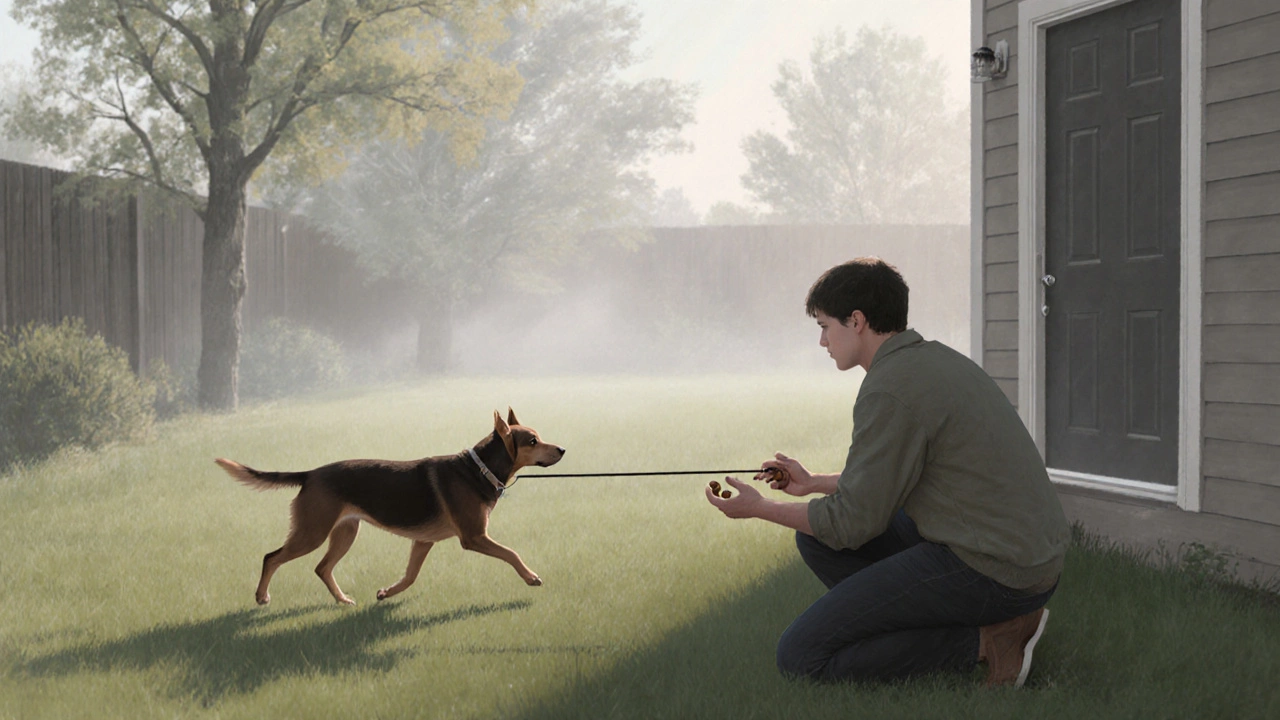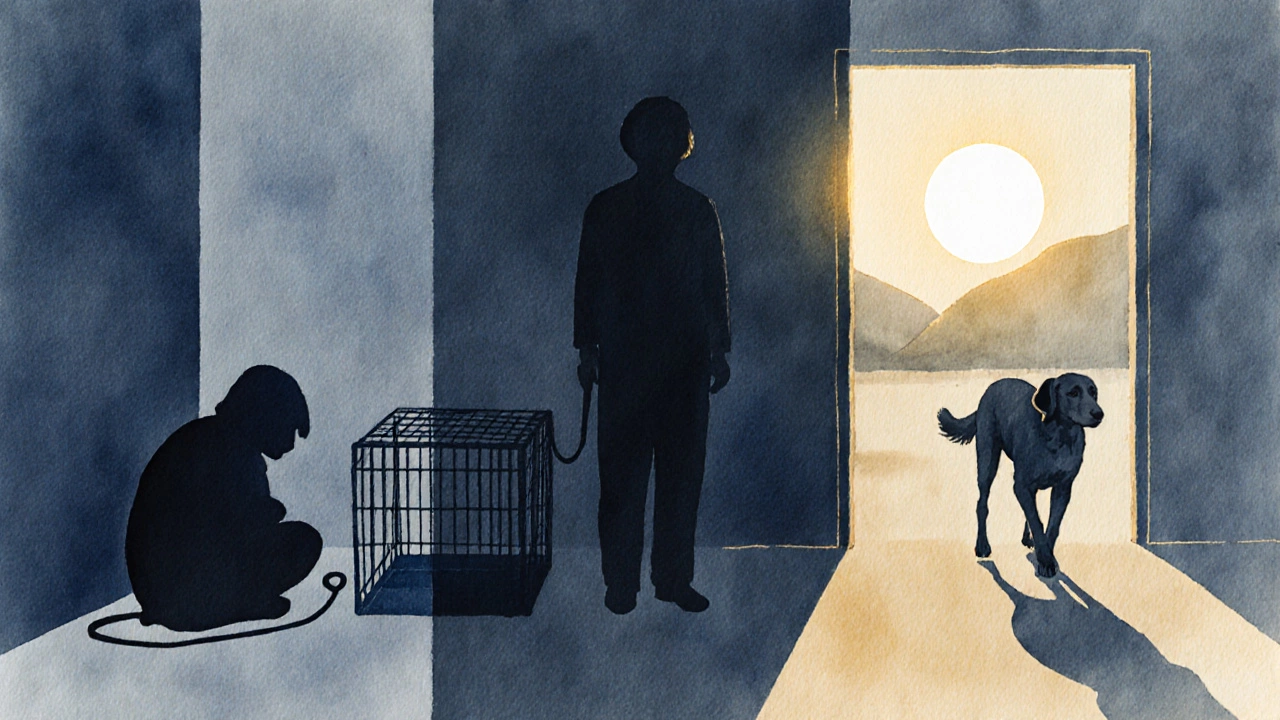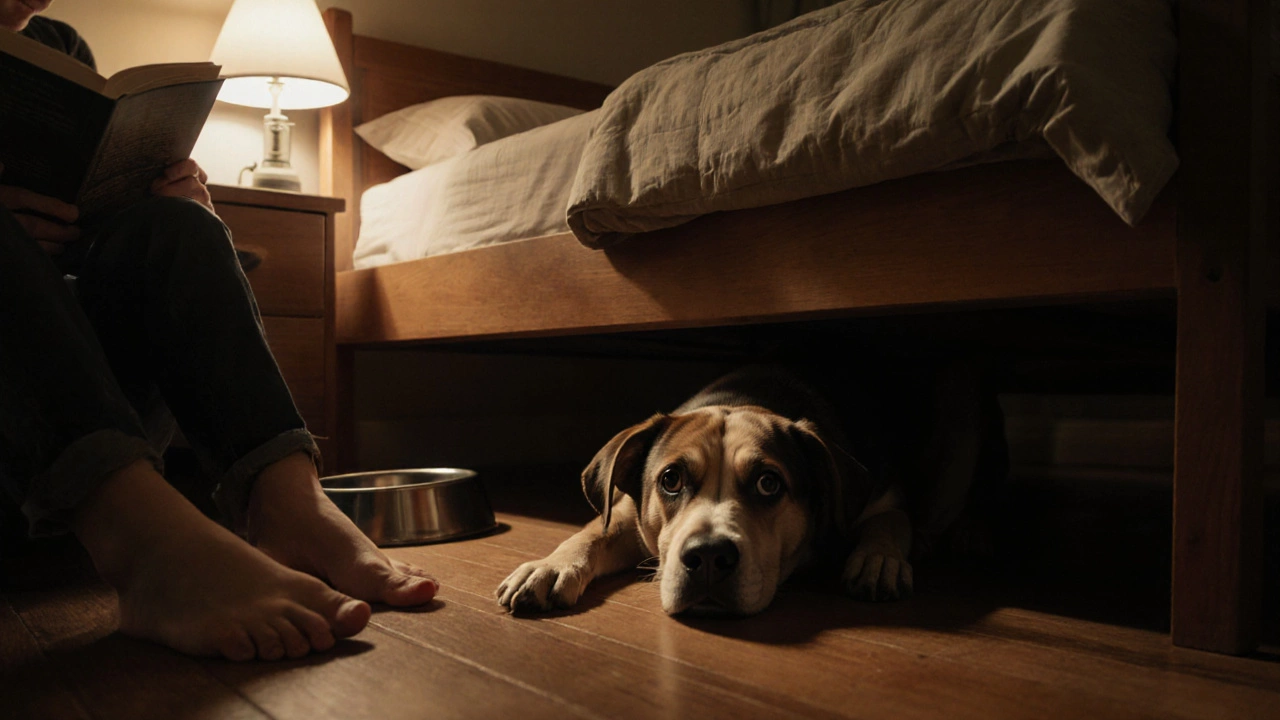Ever heard of the 7-7-7 rule for dogs and wondered if it’s just another internet myth? It’s not. This simple, science-backed method helps dogs-especially new puppies or rescued adults-adjust to their new home without overwhelming them. It’s not magic. It’s structure. And it works.
What Exactly Is the 7-7-7 Rule?
The 7-7-7 rule is a timeline-based approach to help a dog settle into a new environment. It breaks down the first 21 days after adoption or arrival into three clear phases:
- First 7 days: Focus on safety and routine. The dog is in survival mode. They’re watching, hiding, or freezing. Your job isn’t to train-they’re not ready. It’s to build trust.
- Second 7 days: Start introducing structure. The dog begins to relax. Now you can begin basic commands, short walks, and controlled exposure to new sounds and people.
- Third 7 days: Build confidence. The dog starts to explore. This is when you reinforce good behavior, expand their world, and begin socialization beyond the home.
This isn’t about speed. It’s about pacing. Rushing this process is why so many dogs end up in shelters again within months. One study from the University of Edinburgh found that dogs given time to adjust over three weeks showed 68% fewer anxiety-related behaviors compared to those rushed into training.
Why the First 7 Days Are Non-Negotiable
Think of your dog like a refugee. They’ve lost their old world. Maybe they were in a shelter for months. Maybe they were abandoned. Or maybe they came from a home where they never saw a vacuum cleaner. Their brain is flooded with stress hormones. They’re not being ‘bad.’ They’re scared.
During these first seven days:
- Don’t force interaction. Let them come to you.
- Keep the environment quiet. Turn off loud music, limit visitors.
- Feed them on a schedule-same time, same spot. Predictability calms.
- Use a crate or quiet room as their safe zone. Don’t punish if they hide there.
- Ignore attention-seeking whining. Reward calm silence instead.
One owner in Wellington, Sarah, adopted a 2-year-old rescue named Milo. He spent the first five days under the bed. She didn’t try to pull him out. She sat nearby reading aloud. On day six, he crawled out to eat. By day eight, he followed her to the backyard. That’s the 7-7-7 rule in action.
What Happens in Days 8-14?
Now the dog is starting to breathe again. Their body language changes. Ears loosen. Tail wags happen. They might even make eye contact without flinching.
This is when you introduce:
- Short leash walks (5-10 minutes max)
- Basic commands: sit, stay, come-but only in low-distraction areas
- Positive reinforcement with treats or praise
- Gradual exposure to household noises: dishwasher, vacuum, doorbell
Don’t jump to obedience school yet. If you do, you’ll overload them. One trainer in Christchurch reported that 83% of dogs who failed basic training in the second week had been pushed too hard in the first week.
Use treats sparingly-just one at a time. Too many, and you’re training for food, not trust. A single kibble as a reward is enough. The goal isn’t to bribe. It’s to show them: you’re safe here.

Days 15-21: Building Confidence, Not Just Compliance
Now your dog is ready to explore. They might even start to play. That’s your cue.
- Introduce one new person per day-a friend, neighbor, delivery person. Keep it calm.
- Visit quiet parks or empty streets. Let them sniff. Let them wander on leash.
- Practice come in a fenced yard. Reward every time they return, even if it takes 30 seconds.
- Start teaching them where to go potty. Use a consistent phrase like go potty and reward immediately after.
This is also when you start to notice personality. Some dogs are shy. Others are bold. Neither is wrong. The goal isn’t to make them extroverted. It’s to make them secure.
One owner in Dunedin adopted a dog named Luna who hid behind her legs at the sight of other dogs. By day 18, Luna walked past three other dogs on leash without reacting. Not because she was trained to ignore them-but because she finally felt safe enough to stop worrying.
What the 7-7-7 Rule Isn’t
It’s not a checklist. You can’t tick off Day 7 and say, “Okay, now we’re done.” Every dog is different. Some need 28 days. Some need 60. The rule is a guide, not a deadline.
It’s not about teaching tricks. You won’t teach a dog to roll over in the first 21 days. And you shouldn’t try.
It’s not a substitute for vet care. If your dog isn’t eating, is vomiting, or shows signs of illness, see a vet. The 7-7-7 rule helps with behavior, not health.
And it’s not a license to ignore problems. If your dog is aggressive, destructive, or terrified after 21 days, you need professional help. This rule gives you a foundation-but not a cure-all.
Common Mistakes People Make
Even with good intentions, most people mess up the 7-7-7 rule in the same ways:
- Too many visitors: Friends want to meet the new puppy. They swarm. The dog shuts down. Limit guests to one or two per week in the first week.
- Over-training: Trying to teach five commands in three days. Dogs don’t learn like humans. One new thing at a time. That’s it.
- Using punishment: Yelling at a dog for peeing inside. They don’t understand guilt. They understand fear. That fear sticks.
- Skipping the quiet phase: Taking a scared dog to the dog park on day four. That’s not socialization. That’s trauma.
The biggest mistake? Thinking the dog should be ‘fixed’ by now. They’re not a broken appliance. They’re a living creature adjusting to a new world.

What Comes After Day 21?
After the 7-7-7 window, you’re not done-you’re just getting started.
- Begin formal training if you want: recall, loose-leash walking, crate training
- Continue socialization: meet other calm dogs, visit pet-friendly cafes, ride in the car
- Watch for triggers: loud noises, strangers with hats, children running
- Keep routines consistent. Dogs thrive on predictability.
Many owners stop at day 21 because they think the job is done. But real trust takes months. The 7-7-7 rule just gives you the best shot at avoiding the common pitfalls that break bonds before they even form.
Real Results, Real Stories
A rescue group in Auckland tracked 120 dogs that followed the 7-7-7 rule versus 80 that didn’t. After six months:
- 72% of dogs who followed the rule were still with their families
- Only 39% of dogs who were rushed into training stayed
The difference? Not training skills. Not breed. Not age. It was patience.
One dog, a terrier mix named Jasper, spent his first 10 days trembling. His owner didn’t give up. By day 25, he brought his leash to her every morning. He didn’t need to be told. He knew what came next. That’s the power of the 7-7-7 rule.
Is the 7-7-7 rule only for puppies?
No. The 7-7-7 rule works for dogs of any age. Adult dogs, especially those from shelters or previous homes, often need it more than puppies. Their past experiences can make them more fearful. The timeline stays the same, but the pace may be slower. A 5-year-old dog might need 30 days instead of 21. That’s okay.
Can I speed up the 7-7-7 rule if my dog seems fine?
Even if your dog seems happy, don’t rush. Dogs often mask fear. They might eat, sleep, and wag their tail-but still be stressed internally. Wait until day 21 before introducing new environments or people. Rushing leads to behavioral issues later, like sudden aggression or separation anxiety.
What if my dog doesn’t eat during the first week?
It’s common. Stress can suppress appetite. Leave food down for 15-20 minutes, then pick it up. Don’t offer treats or human food. Try warming their kibble slightly with water. If they haven’t eaten in 48 hours, call your vet. But don’t panic-many dogs skip meals for a day or two and start eating when they feel safe.
Should I use a crate during the 7-7-7 rule?
Yes, but only as a safe space-not a punishment. Make it cozy with a blanket and a toy. Leave the door open. Let them choose when to go in. A crate helps reduce anxiety by giving them a den-like place to retreat. Never lock them in for long periods during the first week.
How do I know if my dog is ready for the next phase?
Look for subtle signs: relaxed body posture, tail wagging without fear, making eye contact, approaching you for affection, eating regularly, sleeping without trembling. These are better indicators than loud barking or playing. If they’re calm in quiet rooms and respond to their name, you’re ready to move to day 8.
Final Thought: Patience Is the Best Training Tool
The 7-7-7 rule isn’t about teaching your dog to sit. It’s about teaching them they’re safe. That’s the foundation for everything else-obedience, trust, companionship.
Most people want quick results. But dogs don’t work on our timeline. They work on theirs. And if you give them the time, they’ll surprise you. Not with tricks. But with loyalty. With quiet head leans. With the way they sleep curled against your leg-not because they were trained to, but because they finally chose to.
